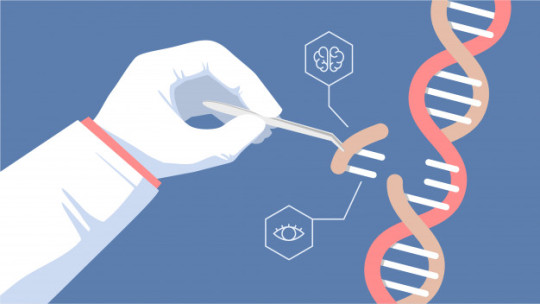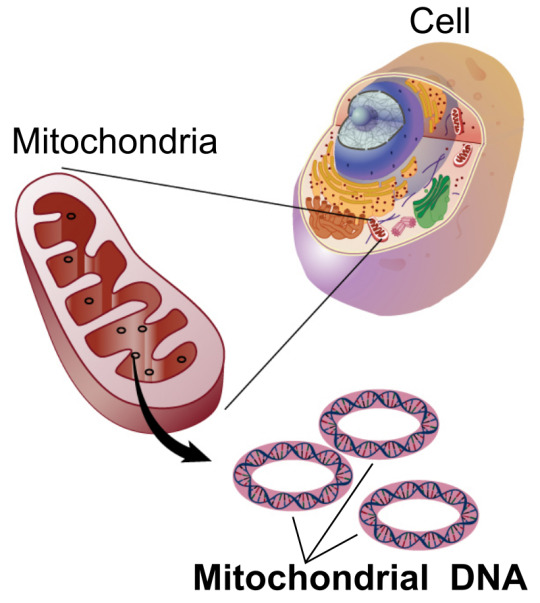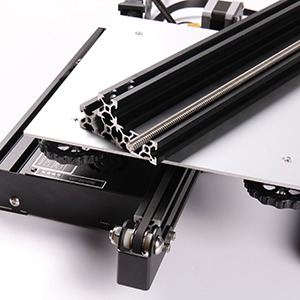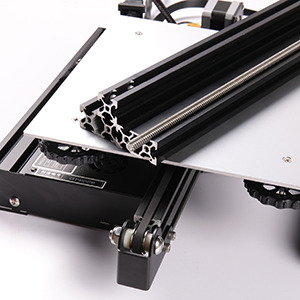Text
Using CRISPR Chinese Scientists Successfully Slow Down Aging in Mice

Detailed in the Science Translational Medicine journal this month is the fact that a team of Chinese scientist in Beijing successfully developed a method with CRISPR in which they used to slow down aging in mice. And these findings may one day be used to do the same in humans.
The team began by identifying genes that they suspect to be key drivers in cellular senescence, a pivotal moment in cells hypothesized to be largely responsible for the aging process. To do this, they performed a genome wide CRISPR-based screen of human cells afflicted with Werner syndrome and Hutchinson progeria syndrome, two conditions leading to premature aging, and identified KAT7 (a specific gene) as a driver of cellular senescence.
After identification, the team inactivated the KAT7 gene in mice via knockout, a process in which a gene is made to be inoperative, and studied the effects of the treatment. What they found was a improved appearance in already aged mice, improved muscular strength, and a 25% increase to their lifespan. They also found zero evidence of cellular toxicity.
Roughly 10,000 genes where screened and 100 of these genes were identified to contribute to cellular senescence, but KAT7 was identified to be the gene that contribute in greater effect to cellular senescence than the others. KAT7 is also generally found in mammals which presented the researchers further opportunity to test the effects across species.
Read the full article
0 notes
Text
Cellular Senescence & Aging: a Key to Achieving Biological Immortality

by Nickoli Parkinson & Editor Elizabeth Lugones
Before discussing cellular senescence, let us first discuss the aging process. During the aging process, organisms undergo significant physiological changes. Sometimes these changes can lead to the development of chronic diseases such as cancer and neuro-degeneration. Billions of dollars have been invested in age-related research which has contributed to new discoveries. However, much more research is needed to develop interventions to prevent age-related diseases. In fact, research suggests that the development of a lot of these diseases can be prevented if the aging process is subverted.
What is Aging?
To understand how the onset of age-related diseases can be prevented by blocking the process of aging, we first must understand what aging is. Aging can be defined as the progressive loss of molecular fidelity after reaching sexual maturity. In other words, there is a decrease in the efficacy of molecular machinery in an organism. This molecular machinery is responsible for maintaining homeostasis and ensuring the continued survival of the organism when it has reached reproductive maturity. However, the efficiency of this molecular machinery gradually deteriorates once reproductive maturity is reached.
As mammals age, they become more susceptible to diseases including cancer, cardiovascular disease, and neurodegeneration.
Read the full article
#CRISPRCas9#CRISPRCas9 GeneticEngineering genetics geneticdisease geneticconditions science scienceblogger sciencenews sciencelover science
0 notes
Text
Limb-Girdle Muscular Dystrophy (LGMD) & Treatment?

Limb-girdle muscular dystrophy (LGMD) are a subset of genetically inherited conditions and gene mutations that progressively weakens voluntary skeletal muscles, generally those most proximal to the hip and shoulder girdles. Collectively, the many different constituents of Limb-Girdle Muscular Dystrophy rank as the fourth most common cause of genetically caused muscular atrophy (degeneration).
(adsbygoogle = window.adsbygoogle || ).push({});
What Causes Limb-Girdle Muscular Dystrophy
So what causes LGMD? The answer lies in your genes. Genes are the functional unit responsible for encoding the proteins that are the building blocks for all of life. This code however is far from perfect and are prone to mutations. When mistakes happen in the genes of an organism, this can lead to complications that may manifest themselves as disease.
This is the case in LGMD. When genes that are responsible for muscle function mutate, proteins vital to normal muscle function, regulation, and repair will not form. Without these proteins, the muscle will lose functionality.
The different types of Limb-Girdle Muscular Dystrophies are classified into two major groups based off their inheritance patterns. LGMD1 and LGMD2. LGMD1 types are inherited autosomal dominant and LGMD2 types are inherited autosomal recessive.
Read the full article
0 notes
Text
Cytoplasmic Inheritance in Multicellular Organisms

Part 1
The Beginning of Life on Earth
Fossilized remains of microscopic life, date the beginning of life to approximately 3.8 billion years ago (though isotopic analysis of zircons could date life to as far back as 4.4 billion years ago.). Though there seems to be consensus on the when, the how life got its start remains a topic that has yet to have been agreed upon.
One of the first models to have been accepted (other than the belief not backed by any scientific evidence that life was created by god), is that life started from a primordial soup of the molecules necessary to form the building blocks of life (Herschy 2014). In this model molecules such as methane, ammonia, hydrogen gas, and water vapor were present in a solution and subjected to an electric shock that catalyzed their reaction to form amino acids, the building blocks of proteins.
(adsbygoogle = window.adsbygoogle || ).push({});
A newer model, however, says life originated near hydrothermal vents deep in the ocean. These vents emit geothermally heated alkaline water, that when mixes with the oceans acidic seawater (the early oceans are thought to contain very high levels of CO2; making it acidic), provided the energy gradient necessary for the production of organic molecules, and then eventually, self-replicating molecules.
Read the full article
0 notes
Text
Limb-Girdle Muscular Dystrophy (LGMD) & Treatment?
Limb-Girdle Muscular Dystrophy (LGMD) & Treatment?
Limb-girdle muscular dystrophy (LGMD) are a subset of genetically inherited conditions and gene mutations that progressively weakens voluntary skeletal muscles, generally those most proximal to the hip and shoulder girdles. Collectively, the many different constituents of Limb-Girdle Muscular Dystrophy rank as the fourth most common cause of genetically caused muscular atrophy (degeneration).
W…
View On WordPress
0 notes
Text
Cytoplasmic Inheritance in Multicellular Organisms
Cytoplasmic Inheritance in Multicellular Organisms
Part 1
The Beginning of Life on Earth
Fossilized remains of microscopic life, date the beginning of life to approximately 3.8 billion year ago (though isotopic analysis of zircons could date life to as far back as 4.4 billion years ago.). Though there seems to be consensus on the when, the how life got its start remains a topic that has yet to have been agreed upon.
One of the first…
View On WordPress
0 notes
Text
HP Agilent 1100 Series RID HPLC System
HP Agilent 1100 Series RID HPLC System
Product features
Agilent 1100 RID, 26230
Product description
HP Agilent 1100 Series RID HPLC System Fully Tested Working 90 day warranty System Includes: G1312A Binary Pump G1313A Autosampler G1322A Degasser G1362A DAD Detector G1316A Column Tray and Bottles computer with software and license Shipping costs ARE AN ESTIMATE ONLY!!
Product details
Shipping…
View On WordPress
0 notes
Text
Agilent 1290 Infinity Series HPLC System Refurbished
Agilent 1290 Infinity Series HPLC System Refurbished
Product features
Agilent 1290, 26230
Product description
Agilent 1290 Infinity Series HPLC System Refurbished G4212A DAD Detector G4220A Binary Pump G4226A Autosampler G1330B Autosampler Thermostat G1316C Thermostatted Column Compartment Solvent Tray Note: Please contact us for SHIPPING QUOTES prior to purchasing. The sale of this item may be subject to regulation by the U.S.…
View On WordPress
0 notes
Text
Monoprice 121666 Mini Delta 3D Printer With Heated (110 x 110 x 120 mm) Build Plate, Auto Calibration, Fully Assembled for ABS & PLA + Free MicroSD Card Preloaded With Printable 3D Models
Monoprice 121666 Mini Delta 3D Printer With Heated (110 x 110 x 120 mm) Build Plate, Auto Calibration, Fully Assembled for ABS & PLA + Free MicroSD Card Preloaded With Printable 3D Models
From the manufacturer


Professional Quality Prints
With Quality & Budget 3D printing, The MP Mini Delta includes features found only on more expensive 3D printers. Despite the amazing price point, this printer is not a toy.
PLA & ABS Filament Supported
ø110 x 120 mm build area
up to 50 Micron Layer Resolution
4.0 LBS weight
Monoprice Mini Delta 3D Printer Auto Calibration | Fully…
View On WordPress
0 notes
Text
Official Creality Open Source CR-10 3D Printer All Metal Frame 12x12x15.5 Inch Build Volume and Heated Bed Includes Glass Bed
Official Creality Open Source CR-10 3D Printer All Metal Frame 12x12x15.5 Inch Build Volume and Heated Bed Includes Glass Bed
Product Description


Well-Known, Established Quality
The Creality 3D CR-10 was our first attempt at creating the perfect 3D printer to fill the gap in the consumer grade market for an exceptional, durable, and simple to operate 3D printer. Over more than a year later, this model continues to surpass expectations as it has grown to be one of the most popular options in its class. The large…
View On WordPress
0 notes
Text
ELEGOO Mars UV Photocuring LCD 3D Printer with 3.5'' Smart Touch Color Screen Off-line Print 4.53in(L) x 2.56in(W) x 5.9in(H) Printing Size Black Version
ELEGOO Mars UV Photocuring LCD 3D Printer with 3.5” Smart Touch Color Screen Off-line Print 4.53in(L) x 2.56in(W) x 5.9in(H) Printing Size Black Version
Product Description

ELEGOO has been manufacturing 3D printer components and parts since 2014 and with years of experience in 3D printing, we finally developed our own 3D printer using UV photocuring technology. We’d like to present you our very first photocuring LCD 3D Printer- ELEGOO Mars.
Great industrial design and user-friendly system, we make ELEGOO Mars suitable for anyone to use…
View On WordPress
0 notes
Text
SainSmart x Creality Ender-3 3D Printer, Resume Printing Prusa i3, for Home and School Use (Copy)
SainSmart x Creality Ender-3 3D Printer, Resume Printing Prusa i3, for Home and School Use (Copy)
From the manufacturer


Ender-3 3D Printer
The Ender-3 is designed specifically for hobbyists on a limited budget. Our most affordable 3D printer, the Ender-3 boasts the same outstanding performance as the CR-10, but is even more compact and affordable.



Home & School Use
Being an entry-level 3D printer, the kit is designed to invite imagination and…
View On WordPress
0 notes
Text
SainSmart x Creality Ender-3 3D Printer, Resume Printing Prusa i3, for Home and School Use
SainSmart x Creality Ender-3 3D Printer, Resume Printing Prusa i3, for Home and School Use
From the manufacturer


Ender-3 3D Printer
The Ender-3 is designed specifically for hobbyists on a limited budget. Our most affordable 3D printer, the Ender-3 boasts the same outstanding performance as the CR-10, but is even more compact and affordable.



Home & School Use
Being an entry-level 3D printer, the kit is designed to invite imagination and…
View On WordPress
0 notes
Text
HIV Cure May Be on The Verge of Discovery

It’s estimated that as of 2020, almost 40 million people have died from an Aids-related illness. However, modern day antiretroviral therapy (ART) make HIV a livable disease. With ART becoming more accessible worldwide, deaths related to HIV/AIDS illnesses are on a steep decline. But with 37.9 people still living with HIV as of 2018, scientists have not become complacent in the search for an HIV cure. And after decades of searching, scientists are discovering that with gene therapy, the elusive HIV cure may be on the verge of discovery.
(adsbygoogle = window.adsbygoogle || ).push({});
Since the discovery of the Human Immunodeficiency Virus (HIV for short) in 1983, scientists has searched for an Hiv cure to no avail. But in the mid 1990s scientists, scientists made an astonishing discovering in Stephen Crohn, a man who appeared to be immune to contracting the virus.
Stephen, researchers found had a mutation in the CCR5 gene which prevented him from, despite being exposed to HIV, contracting the disease. This led to decades long interest in this gene mutation, one they coined CCR5 delta 32. Furthermore, compounding on this discovery were two people who after receiving a bone marrow transplant of hematopoietic stem cells from people with the natural occurring CCR5 delta 32 mutation, had their HIV sent into remission. In fact, CCR5 is the very gene that was altered in Lulu and Nana (pseudonyms) in an attempt to induce a natural immunity to HIV in the twin girls.
The HIV Cure
The HIV cure seems to be in resetting a persons immune system with transplant of hematopoietic stem cells containing the CCR5 delta 32 mutation, but bone marrow transplants for 37.9 million people is not entirely a viable option. For one, just one percent of a tiny demographic off the population contain this gene. Two, bone marrow transplants are dangerous to its recipients. There is always the chance that the recipients body reject the transplant. This is where gene therapy come into play.
In one practical application, researchers from Temple University and the University of Nebraska Medical Center were able to completely eliminate the virus from humanized mice by combining both ART and CRISPR gene editing. It should be noted however that this treatment was not able to cure all the mice that were infected with HIV, but nevertheless was able to remove the virus from some of the mice. Now they are hoping to move to human trials sometime in 2020.
(adsbygoogle = window.adsbygoogle || ).push({});
In the private sector, another company American Gene Technologies are trying to induce the protective mutation in HIV patients and if successful, will rid patients of the deadly virus. The experimental therapy includes separating the T-cells from about 400 millimeters of blood from an HIV patient, incubating those T-cells, then engineering those cells with the desired mutation, two weeks later those cells will then be infused back into the patient. This process is supposed to be a one time treatment that will cure the patient of HIV. The company is expected to open enrollment for the clinical trials this February of 2020.
Going Forward
Though I provided only two entities, numerous companies and educational institutions around the word are pursuing an HIV cure along the gene therapy avenue. However, once we successfully find the cure via gene therapy, as I believe we inevitably will, the challenge of making said therapy affordable to the estimated 40 million people worldwide living with HIV remains. Despite these challenges however gene therapy is still the most likely candidate for providing us with an HIV cure.
(adsbygoogle = window.adsbygoogle || ).push({});
Read the full article
0 notes
Text
HIV Cure May Be on The Verge of Discovery
HIV Cure May Be on The Verge of Discovery
It’s estimated that as of 2020, almost 40 million people have died from an Aids-related illness. However, modern day antiretroviral therapy (ART) make HIV a livable disease. With ART becoming more accessible worldwide, deaths related to HIV/AIDS illnesses are on a steep decline. But with 37.9 people still living with HIV as of 2018, scientists have not become complacent in the search for an HIV…
View On WordPress
0 notes
Text
CRISPR Babies Scientist Sentenced To Jail Time

He Jiankui, the biophysicist who back in November of 2018 claimed in an online video that he genetically modified the embryo of two unborn twin girls creating the worlds first CRISPR babies, has been sentenced to 3 years in jail and fined about $430,000 for a charge of “illegal medical practice” by a Chinese court in Shenzhen. Two other colleagues, Zhang Renli and Qin Jinzhou, who assisted He plead guilty and were also handed sentences. The trial also brought to light the fact that He’s team had falsified their regulatory paperwork.
(adsbygoogle = window.adsbygoogle || ).push({});
November 25, 2018, in a viral video that shocked the scientific community, He Jiankui announces that the first CRISPR babies are here. In the video, He Jiankui claims that he used CRISPR-Cas9, a gene-editing tool, to modify a gene that, when expressed, codes for a protein receptor used by HIV to infiltrate and infect white blood cells. This new modification would supposedly mutate the gene to a different form which would render the twins immune from contracting specific strains of the viral disease.
He Jiankui announces to the world that he modified human embryos with CRISPR-Cas9
His announcement was followed swiftly by a barrage of criticism from not the media, but also his scientific peers. Groups all around the world questioned the ethics his actions and scientist questions efficacy of the experiment. Not only that but concerns were raised about the unintended consequences of what would happen when changes to the human genome, which the effects we cant yet predict, are passed down into the population.
During the trial, Chinese authorities stated that, “None of the three defendants acquired doctor’s qualifications. craved fame and fortune, and deliberately went against the country’s regulations on scientific research and medical management. went beyond the bottom lines of scientific research and medical ethics,” according to Kinling Lo from a report in South China Morning Post.
All three of the defendants admitted to the charges and other personal that was involved in the experiment were blacklisted and banned from their field and all jobs related.
Read the full article
0 notes
Text
CRISPR Babies Scientist Sentenced To Jail Time
CRISPR Babies Scientist Sentenced To Jail Time
He Jiankui, the biophysics who back in November of 2018 claimed in an online video that he genetically modified the embryo of two unborn twin girls creating the worlds first CRISPR babies, has been sentenced to 3 years in jail and fined about $430,000 for a charge of “illegal medical practice” by a Chinese court in Shenzhen. Two other colleagues, Zhang Renli and Qin Jinzhou, who assisted He…
View On WordPress
0 notes